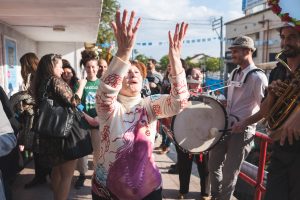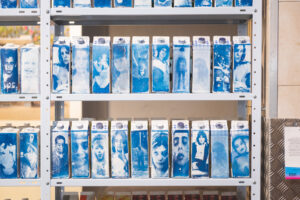The biggest challenge faced by Zumu is the creation of a genuine and meaningful connection between the portable museum and its host communities. On the face of it, there is no overlap between contemporary artistic discourse and the internal discourse in all of the communities in the cities and towns that have hosted the museum. Zumu’s journey throughout the country is a determined attempt to prove the opposite. Its purpose is to demonstrate how art can ignite conversation, creative cross-pollination and generate groundbreaking collaborations that change consciousness.
Zumu’s community department, which is headed by Sharon Glazberg, spearheads our work. The first thing Zumu does in a host city, even before signing a contract with the local authority, is in-depth research into its residents to map the various communities, identify the issues that are important to them, locate key community activists and lay the groundwork for Zumu’s engagement with the city.
The findings of this preparatory work are translated into art and integrated into every exhibition staged on our journey.
.

The artist residency program plays the most signifcant role in connecting our research into the community to the exhibition. The program invites three to five artists to spend a month in the host city, before the opening of the museum, and to create a new artwork, especially for us, based on their stay in the selected city/town, the connections generated with the local population and the information gathered about subjects that are important to the local communities. Participating artists thus far: Zohar Gottesman, Guy Königstein, Tailors Group, Natalia Zourabova (Arad), Dafna Shalom, Dafna Talmon, Studio Mala (Carmel Bar and Michal Avitar), Sally Krysztal-Kramberg (Hatzor HaGlilit), Chen Varsano, Noa Zeni, Keren Ben Rafael, Tamar Katz (Kiryat Yam).

Zumu has also, since its first stop, issued invitations to leading artists, residents and guests, to create artworks for the museum that relate directly to the exhibition topic as part of its community-based activities. The works are drawn from local know-how and traditions, which serve as meaningful connectors for guest audiences. An example is Israel Prize winner Micha Ullman, who used sand taken from the area surrounding Tel Hatzor to create an artwork for Zumu Hatzor HaGlilit. An additional example is a piece created by Guy Kaplan for Zumu Yeruham–the artist painted directly onto construction waste, which he found in the city, and then brought it back into the museum.

Ha’asif, Zumu’s socio-museum collection, and one of our flagship projects is also a community-based art project that collects cultural treasures in every stop and turns them into artwork.
The curriculum for Zumu’s school for cultural entrepreneurship comprises 10 meetings that are spread over a year, in which Zumu’s educational team teach a different subject every day: cultural entrepreneurship, curation, production, design, communications and more that combined, create a sustainable infrastructure for continued culture initiatives. The fellows have an opportunity to hone their skills, leverage the connections they made during Zumu’s stay in their city, meet creatives and cultural entrepreneurs responsible for events all over the country, further explore the possibilities presented by the integration of art, community and education, and acquire the necessary tools to create community-based art and cultural events independently.
Media error: Format(s) not supported or source(s) not found
Download File: https://zumu.org.il/wp-content/uploads/2021/01/WhatsApp-Video-2021-01-19-at-18.47.59.mp4?_=1














